Description
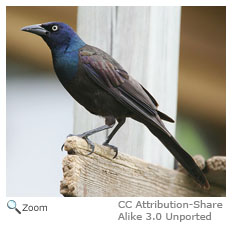 The Common Grackle is a social, noisy relative of the blackbird. The Grackle looks very similar to the blackbird, but is slightly longer with glossy, iridescent feathers. It has a purple head and a bronze body. Look for Grackles gathered in large, noisy flocks with cowbirds and blackbirds. The Common Grackle is a social, noisy relative of the blackbird. The Grackle looks very similar to the blackbird, but is slightly longer with glossy, iridescent feathers. It has a purple head and a bronze body. Look for Grackles gathered in large, noisy flocks with cowbirds and blackbirds.
Range
The Common Grackle can be found throughout the eastern United States year-round. In the summer, the Common Grackle spreads north through eastern Canada and west into the Rocky Mountains.
Habitat
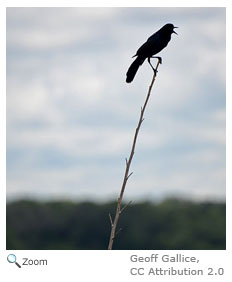 The Common Grackle is found in many different environments. It lives in agricultural fields, city parks, backyards, open woodlands, forest edges, meadows and marshes. It can be seen sitting on telephone lines and walking across lawns. The only place you probably won't find a Grackle is in a dense forest. The Common Grackle is found in many different environments. It lives in agricultural fields, city parks, backyards, open woodlands, forest edges, meadows and marshes. It can be seen sitting on telephone lines and walking across lawns. The only place you probably won't find a Grackle is in a dense forest. |
|
Diet
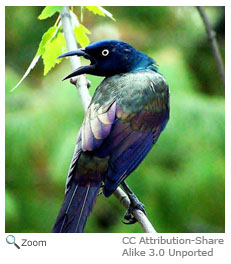 The Common Grackle is a resourceful forager and has a varied diet. It eats many types of seeds, including crops such as corn from farm fields. The Common Grackle will also wade into the water to catch a small fish, pick leeches off turtles, steal worms from other birds and on occasion, eat other adult birds. The Common Grackle has a hard section of their beak that they use for sawing open acorns. The Common Grackle is a resourceful forager and has a varied diet. It eats many types of seeds, including crops such as corn from farm fields. The Common Grackle will also wade into the water to catch a small fish, pick leeches off turtles, steal worms from other birds and on occasion, eat other adult birds. The Common Grackle has a hard section of their beak that they use for sawing open acorns.
Life Cycle
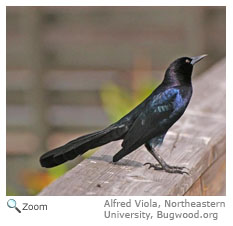 Females build a bulky cup-shaped nest made of twigs, leaves and grasses with small bits of paper, string, cloth and corn husks. She reinforces the nest with mud and lines it with fine grass and horse hair. She lays 1-7 inch-long blue-gray eggs, which she incubates for 11-15 days. After hatching, the chicks stay in the nest for about two weeks. Females build a bulky cup-shaped nest made of twigs, leaves and grasses with small bits of paper, string, cloth and corn husks. She reinforces the nest with mud and lines it with fine grass and horse hair. She lays 1-7 inch-long blue-gray eggs, which she incubates for 11-15 days. After hatching, the chicks stay in the nest for about two weeks.
Behavior
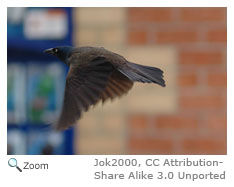 The Common Grackle sometimes performs a behavior called "anting". The Grackle bows down to the ground and lets ants crawl all over its body. The ants secrete formic acid onto the body of the Grackle, which scientists think may help the Common Grackle get rid of parasites. The Common Grackle sometimes performs a behavior called "anting". The Grackle bows down to the ground and lets ants crawl all over its body. The ants secrete formic acid onto the body of the Grackle, which scientists think may help the Common Grackle get rid of parasites. |





